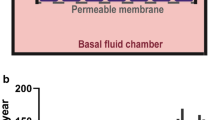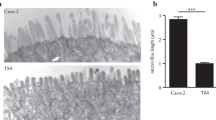Abstract
The gastrointestinal tract remains the most popular and acceptable route of administration for drugs. It offers the great advantage of convenience and many compounds are well absorbed and thereby provide acceptable plasma concentration-time profiles. Currently there is considerable interest from the pharmaceutical industry in development of cell culture systems that would mimic the intestinal mucosa in order to evaluate strategies for investigating and/or enhancing drug absorption. The intestinal epithelial cells of primary interest, from the standpoint of drug absorption and metabolism, are the villus cells, which are fully differentiated cells. Anin vitro cell culture system consisting of a monolayer of viable, polarized and fully differentiated villus cells, similar to that found in the small intestine, would be a valuable tool in the study of drug and nutrient transport and metabolism.
The Caco-2 cell line, which exhibits a well-differentiated brush border on the apical surface and tight junctions, and expresses typical small-intestinal microvillus hydrolases and nutrient transporters, has proven to be the most popularin vitro model (a) to rapidly assess the cellular permeability of potential drug candidates, (b) to elucidate pathways of drug transport (e.g., passive versus carrier mediated), (c) to assess formulation strategies designed to enhance membrane permeability, (d) to determine the optimal physicochemical characteristics for passive diffusion of drugs, and (e) to assess potential toxic effects of drug candidates or formulation components on this biological barrier. Since differentiated Caco-2 cells express various cytochrome P450 isoforms and phase II enzymes such as UDP-glucuronosyltransferases, sulfotransferases and glutathione-S-transferases, this model could also allow the study of presystemic drug metabolism.
Similar content being viewed by others
References
Anderberg EK, Artursson P. Epithelial transport of drugs in cell culture. VIII: Effects of sodium dodecyl sulfate on cell membrane and tight junction permeability in human intestinal epithelial Caco-2 cells. J Pharm Sci. 1993;82:392–8.
Anderberg EK, Nystrom C, Artursson P. Epithelial transport of drugs in cell culture. VII: Effects of pharmaceutical surfactant excipients and bile acids on transepithelial permeability in monolayers of human intestinal epithelial Caco-2 cells. J Pharm Sci. 1992;81:879–87.
Artursson P. Epithelial transport of drugs in cell culture. I: A model for studying the passive diffusion of drugs over intestinal absorptive Caco-2 cells. J Pharm Sci. 1990;79:746–82.
Artursson P. Cell culture as models for drug absorption across the intestinal mucosa. Crit Rev Ther Drug Carrier System. 1991;8:105–30.
Artursson P, Karlsson J. Correlation between oral drug absorption in humans and apparent drug permeability coefficients in human intestinal epithelial Caco-2 cells. Biochem Biophys Res Commun. 1991;175:880–5.
Artursson P, Magnusson C. Epithelial transport of drugs in cell culture. II: Effects of extracellular calcium concentration on the paracellular transport of drugs of different lipophilicities across monolayers of intestinal epithelial Caco-2 cells. J Pharm Sci. 1990;79:595–600.
Augeron C, Laboisse C. Emergence of permanently differentiated cell clones in human colonic cancer cell line in culture after treatment with sodium butyrate. Cancer Res. 1984;44:3961–9.
Baranczyk-Kuzma A, Garren JA, Hidalgo J, Borchardt R. Substrate specificity and some properties of phenol sulfotransferase from human intestinal Caco-2 cells. Life Sci., 1991;49:1197–206.
Bjorge S, Hamelehle KL, Homan R, Rose SE, Turluck DA, Wright DS. Evidence for glucuronide conjugation ofp-nitrophenol in the Caco-2 cell model. Pharm Res. 1991;8:1441–3.
Blais A, Bissonette T, Berteloot A. Common characteristics for Na+-dependent sugar transport in Caco-2 and human fetal colon. J Membr Biol. 1987;99:113–25.
Boulenc X, Bourrié M, Fabre I et al. Regulation of cytochrome P450IA1 expression in a human intestinal cell line, Caco-2. J Pharmacol Exp Ther. 1992;263:1471–8.
Boulenc X, Marti E, Roques C, Joyeux H, Berger Y, Fabre G. Importance of the paracellular pathway for the transport of a new biphosphonate using the human Caco-2 monolayer model. Biochem Pharmacol. 1993;46:1591–1600.
Brandsch M, Miyamoto Y, Ganapathy V, Leibach FH. Regulation of taurine transport in human colon carcinoma cell lines (HT-29 and Caco-2) by protein kinase C. Am J Physiol. 1993;264:939–46.
Caro I, Boulenc X, Rousset M et al. Characterisation of a newly isolated Caco-2 clone (TC-7), as a model of transport processes and biotransformation of drugs. Int J Pharm. 1995;116:147–58.
Carrière V, Lesuffleur T, Barbat A et al. Expression of cytochrome P4503A in HT29-MTX and Caco-2 clone TC-7. FEBS Lett. 1994;355:247–50.
Carrière V, Rousset M, Brot-Laroche E et al. Induction in Caco-2 cells of cytochrome P4501A1 results in a coordinate inverted expression of sucrase isomaltase and hexose transporters SGLT1, GLUT1, GLUT2, GLUT3 and GLUT5. [submitted].
Chantret I, Rodolosse A, Barbat A et al. Differential expression of sucrose-isomaltase in clones isolated from early and late passages of the cell line Caco-2: evidence for a glucose-dependent negative regulation. J Cell Sci. 1994;107:213–25.
Cohen MB, Jensen NJ, Hawkins JA et al., Receptors forEscherichia coli heat stable enterotoxin in human intestine and in a human intestinal cell line (Caco-2). J Cell Physiol. 1993;156:138–44.
Cogburn JN, Donovan MG, Schasteen CS. Correlation of Caco-2 transport with human oral bioavailability. J Controlled Release. 1990;13:314–5.
Dantzig AH, Bergin L. Carrier-mediated uptake of cephalexin in human intestinal cells. Biochem Biophys Res Commun. 1988;155:1082–7.
Dantzig AH, Tabas LB, Bergin L. Cephaclor uptake by the proton-dependent dipeptide transport carrier of human intestinal Caco-2 cells and comparison to cephalexin uptake. Biochim Biophys Acta. 1992;1112:167–73.
De Boer AG, Van Hoogdalen EJ, Breimer DD. Improvement of drug absorption through enhancers. Eur J Drug Metab Pharmacokin. 1990;15:155–7.
De Wazier I, Cugnenc PH, Yang CS, Leroux JP, Beaune PH. Cytochrome P450 isozymes, epoxide hydrolases and glutathioneS-transferases in rat and human, hepatic and extrahepatic tissues. J Pharm Exp Ther. 1990;253:187–94.
Dhamsathaphorn K, McRoberts JA, Mandel KG, Tisdale LD, Masui H. A human colonic tumor cell line that maintains vectorial electolyte transport. Am J Physiol (Gastroint Liver Physiol). 1984;246:G204–8.
Dix CJ, Hassan H, Obray HY, Stah R, Wilson G. The transport of vitamin B12 through polarized monolayers of Caco-2 cells. Gastroenterology. 1990;98:1272–9.
Fabre G, Bourrié M, Meunier V, Berger Y. Utilisation de modèlesex vivo etin vitro pour l'évaluation de la biodisponibilité des médicaments. In: In vitro models for drug transport across epithelial and endothelial barriers. Ateliers de Formation de l'INSERM No. 67. Paris: Editions de l'INSERM; 1994.
Field FJ, Fujiwara D, Born E, Chappell DA, Mathur SN. Regulation of LDL receptor expression by luminal sterol flux in Caco-2 cells. Aterioscler Thromb. 1993;13:729–37.
Fogh J, Fogh JM, Orfeo T. One hundred and twenty-seven cultured human tumor cell lines producing tumors in nude mice. J Natl Cancer Inst. 1977;59:221–5.
Hauck W, Stanners CP. Control of carcinoembryonic antigen gene family expression in a differentiating colon carcinoma cell line, Caco-2. Cancer Res. 1991;51:3526–33.
Hauri HP, Sterchi EE, Bienz D, Fransen MA, Marxer A. Expression of intracellular transport of microvillus membrane hydrolases in human intestinal epithelial cells. J Cell Biol. 1985;101:838–51.
Hidalgo U, Borchardt RT. Transport of bile acids in a human intestinal epithelial cell line, Caco-2. Biochim Biophys Acta. 1990;1035:97–103.
Hidalgo U, Raub TJ, Borchardt RT. Characterization of the human colon carcinoma cell line, Caco-2 as a model system for intestinal epithelial permeability. Gastroenterology. 1989;96:736–49.
Hoeflich A, Yang Y, Kessler U. Human colon carcinoma cells (Caco-2) synthesize IGF-II and express IGF-I receptors and IGF-II/M6P receptors. Mol Cell Endocrinol. 1994;101: 141–50.
Howell S, Kenny AJ, Turner AJ. A survey of membrane peptidases in two human colonic cell lines, Caco-2 and HT-29. Biochem J. 1992;284:595–601.
Hu HM, Borchardt RT. Mechanism ofl-α-methyldopa transport through a monolayer of polarized human intestinal epithelial cells Caco-2. Pharm Res. 1990;7:1313–9.
Huet C, Sahuquillo-Merino C, Coudrier E, Louvard D. Absorptive and mucus-secreting subclones isolated from a multipotent intestinal cell line (HT-29) provide new models for cell polarity and terminal differentiation. J Cell Biol. 1987;105:345–57.
Hunter J, Jepson MA, Tsuruo T, Simmons NL, Hirst BH. Functional expression of P-glycoprotein in apical membranes of human intestinal Caco-2 cells. J Biol Chem. 1993;268:14991–7.
Jalal F, Jumarie C, Bawab W et al. Polarized distribution of neutral endopeptidase 24.11 at the cell surface of cultured human intestinal epithelial Caco-2 cells. Biochem J. 1992;288:945–51.
Jumarie C, Malo C. Caco-2 cells cultures in serum-free medium as a model for the study of enterocytic differentiation in vitro. J Cell Physiol. 1991;149:24–33.
Karlsson J, Artursson P. A new diffusion chamber system for the determination of drug permeability coefficients across the human intestinal epithelium that are independent of the unstirred water layer. Biochim Biophys Acta. 1992;1111: 204–10.
Laburthe M, Rousset M, Rouyer-Fessard C et al. Development of vasoactive intestinal peptide-responsive adenylate cyclase during enterocytic differentiation of Caco-2 cells in culture: evidence for an increased receptor level. J Biol Chem. 1987;262:10180–4.
Lesuffleur T, Barbat A, Dussaulx E, Zweibaum A. Growth adaptation to methotrexate of HT-29 human colon carcinoma cells is associated with their ability to differentiate into columnar absorptive and mucus-secreting cells. Cancer Res. 1990;50:6334–43.
Mahraoui L, Rousset M, Dussaulx E, Darmoul D, Zweibaum A, Brot-Laroche E. Expression and localisation of GLUT-5 in Caco-2 cells, human small intestine and colon. Am J Physiol (Gastroint Liver Physiol 26). 1992;263:G312–8.
Mahraoui L, Rodolosse A, Barbat A et al. Presence and differential expression of SGLT1, GLUT1, GLUT2, GLUT3 and GLUT5 hexose-transporter mRNAs in Caco-2 cell clones in relation to cell growth and glucose consumption. Biochem J. 1994;298:629–33.
Peters WH, Roelofs HM. Time-dependent activity and expression of glutathioneS-transferases in the human colon adenocarcinoma cell line Caco-2. Biochem J. 1989;264: 613–6.
Peterson MD, Mooseker MS. An in vitro model for the analysis of intestinal brush border assembly. 1. Ultrastructural analysis of cell contact-induced brush border assembly in Caco-2BBE cells. J Cell Sci. 1993;105:445–60.
Pinto M, Robine-Leon S, Appay MD et al. Enterocyte-like differentiation and polarization of the human colon carcinoma cell line Caco-2 in culture. Biol Cell. 1983;47:323–30.
Rosenberg DW, Leff T. Regulation of cytochrome P450 in cultured human colonic cells. Arch Biochem Biophys. 1993;300:186–92.
Rousset M, Chantret I, Darmoul D et al. Reversible forskolin-induced impairment of sucrase isomaltase mRNA levels, biosynthesis and transport to the brush border membrane in Caco-2 cells. J Cell Physiol. 1989;141:627–35.
Rubas W, Jezyk N, Grass GM. Comparison of the permeability characteristics of a human colonic epithelial Caco-2 cell line to colon of rabbit, monkey and dog intestine and human drug absorption. Pharm Res. 1993;10:113–8.
Sergent-Engelen T, Delistrie V, Schneider. Phase I and II biotransformations in living Caco-2 cells cultivated under serum-free conditions; selective apical excretion of reaction products. Biochem Pharmacol. 1993;46:1393–401.
Wikman A, Karlsson J, Carlstedt I, Artursson P. A drug absorption model based on the mucus layer producing human intestinal goblet cell line HT29-H. Pharm Res. 1993;10:843–52.
Wils P, Legrain S, Frenois E, Scherman D. HT29-18C1 intestinal cells: a new model for studying the epithelial transport of drugs. Biochim Biophys Acta. 1993;1177:134–8.
Wils P, Warnery A, Phung-Ba V, Scherman D. Differentiated intestinal epithelial cell lines as in vitro models for predicting the intestinal absorption of drugs. Cell Biol Toxicol. 1994;10:393–7.
Woodcock S, Williamson I, Hassan I, Mackay M. Isolation and characterization of clones from the Caco-2 cell line displaying increased taurocholic acid transport. J Cell Sci. 1991;98:323–32.
Zweibaum A, Hauri HP, Sterchi E et al. Immunohistological evidence obtained with monoclonal antibodies of small intestine brush border hydrolases in human colon cancers and foetal colons. Int J Cancer. 1984;34:591–8.
Zweibaum A, Pinto M, Chevalier G et al. Entercytic differentiation of a subpopulation of the human colon tumor cell line HL-29 selected for growth in sugar-free medium and its inhibition by glucose. J Cell Physiol. 1985;122:21–9.
Zweibaum A, Lesuffleur T, Barbat A et al. Colon cancer cell differentiation as related to methotrexate and 5-fluorouracil resistance. In: D'Allesandro R, Mihich E, Rausa L, Tapiero, eds. Cancer therapy: differentiation, immunomodulation and angiogenesis. Berlin: Springer Verlag; 1993:75:1–15.
Author information
Authors and Affiliations
Rights and permissions
About this article
Cite this article
Meunier, V., Bourrié, M., Berger, Y. et al. The human intestinal epithelial cell line Caco-2; pharmacological and pharmacokinetic applications. Cell Biol Toxicol 11, 187–194 (1995). https://doi.org/10.1007/BF00756522
Accepted:
Issue Date:
DOI: https://doi.org/10.1007/BF00756522




